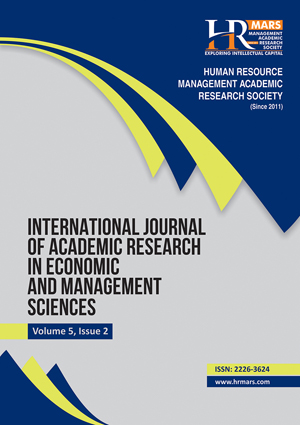
ISSN: 2226-3624
Open access
This paper investigates the causal relationship between education and GDP in a panel of 11 selected oil exporting countries by using panel unit root tests and panel co-integration analysis for the period 1970-2014. A three-variable model is formulated with oil revenues as the third variable. The results show a strong causality from oil revenues and economic growth to education in the oil exporting countries. Yet, education does not have any significant effects on GDP in short- and long-run. It means that it is the oil and GDP that drives education in mentioned countries, not vice versa. So the findings of this paper support the point of view that it is higher economic growth that leads to higher education proxy. It seems that as the number of enrollments raise, the quality of the education declines. Moreover, the formal education systems are not market oriented in these countries. This may be the reason why huge educational investments in these developing countries fail to generate higher growth. By promoting practice-oriented training for students particularly in technical disciplines and matching education system to the needs of the labor market, it will help create long-term jobs and improve the country’s future prospects.
Aghion P., Howitt P. 1998 Endogenous growth theory, MIT Press.
Alderman H., Behrman J. R., Ross D. R., Sabot R. 1996. The returns to endogenous human capital in Pakistan’s rural wage labour market, Oxford Bulletin of Economics and statistics, 58, 29-55.
Anderson T.W., Hsiao C. 1981. Estimation of dynamic models with error components. Journal of the American Statistical Association, 76, 598-606.
Arellano M., Bond S.R. 1991. Some tests of specification for panel data: Monte Carlo evidence and an application to employment equations. Review of Economic Studies, 58, 277-297.
ArellanoM., Bover O. 1995. Another look at the instrumental variable estimation of error-component models, Journal of Econometrics, 68, 29-51.
Barro R.J. 1991. Economic growth in a cross-section of countries, Quarterly Journal of Economics, 106, 407-443.
Barro R.J. 1999. Human capital and growth in cross-country regressions, Swedish Economic policy Review, 6, 237-277.
Barro R.J., Lee J.W. 1996. International measures of schooling years and schooling quality, American Economic Review, 86, 218-223.
Barro R.J., Sala-i-Martin X. 1995. Economic Growth, Mc-Graw Hill, New York.
Benhabib J., Spiegel M.M. 1994. The role of human capital in economic development. Evidence from aggregate cross-country data, Journal of Monetary Economics, 34, 143-173.
Bils M., Klenow P. 1998. Does schooling cause growth or the other way around?” NBER Working Paper 6393.
Granger, C. W. J., 1969. Investigating Causal Relations by Econometric Models and Cross-spectral Methods, Econometrica 37 (3): 424-438.
Granger, C. W. J., 1988. Some Recent Developments in a Concept of Causality, Journal of Econometrics 39: 199–211.
Harrod, R. F., 1939. An Essay on Dynamic Theory. Economic Journal 49: 14–33.
Hatanaka, M., 1996. Time-Series-Based Econometrics: Unit Roots and Co-integration. Oxford University Press, Oxford.
Im, K. S., Pesaran, M. H., and Shin, Y., 1997. Testing for Unit Roots in Heterogeneous Panels, University of Cambridge, Department of Applied Economics.
Im, K. S., Pesaran, M. H., and Shin, Y., 2003. Testing for Unit Roots in Heterogeneous Panels, Journal of Econometrics 115: 53–74.
Levin, A., Lin, C.F., 1992. Unit Root Tests in Panel Data: Asymptotic and Finite Sample Properties.Department of Economics, University of California at San Diego, Working Paper 92–23.
Levin, A., Lin. C. F., 1993. Unit Root Test in Panel Data: New Results. Department of Economics, University of California, San Diego, Working paper 93-56.
Levin, A., Lin, C. F., and Chu, C. S. J. 2002. Unit Root Test in Panel Data: Asymptotic and Finite Sample Properties. Journal of Econometrics 108: 1-24.
Masih, A.M.M., Masih, R., 1996. Energy consumption, real income and temporal causality: results from a multi-country study based on cointegration and error-correction modeling techniques. Energy Economics 18:165–183.
Pedroni, P., 1995,Panel Cointegration: Asymptotic and Finite Sample Properties of Pooled Time Series Tests, with an Application to the PPP Hypothesis. Indiana University, Working Papers in Economics, No. 95-013.
Pedroni, P., 1997, Panel Cointegration: Asymptotic and Finite Sample Properties of Pooled Time Series Tests, with an Application to the PPP Hypothesis: New results, India University, Working Papers in Economics.
Pedroni, P., 1999. Critical Values for Cointegration Tests in Heterogeneous Panels with Multiple Regressors. Oxford Bulletin of Economics and Statistics 61 (4): 5–49.
Pedroni, P., 2004. Panel Cointegration: Asymptotic and Finite Sample Properties of Pooled Time Series Tests with an Application to the PPP Hypothesis: New Results. Econometric Theory 20 (3): 597–627.
Pesaran, M. H., Shin Y., 1997. An Autogressive Distributed Lag Modelling Approach to Cointegration Analysis, Working Paper Trinity College, Cambridge.
Solow, R. M., 1956. A Contribution to the Theory of Economic Growth. Quarterly, Journal of Economics 70: 65–94.
(Mehrara et al., 2016)
Mehrara, M., Shafizadeh, R., & Karsalari, A. R. (2016). The Education and GDP Growth in Oil Exporting Countries: Panel Causality Approach. International Journal of Academic Research in Economics and Management Sciences, 5(1), 23–29.
Copyright: © 2018 The Author(s)
Published by Human Resource Management Academic Research Society (www.hrmars.com)
This article is published under the Creative Commons Attribution (CC BY 4.0) license. Anyone may reproduce, distribute, translate and create derivative works of this article (for both commercial and non-commercial purposes), subject to full attribution to the original publication and authors. The full terms of this license may be seen at: http://creativecommons.org/licences/by/4.0/legalcode